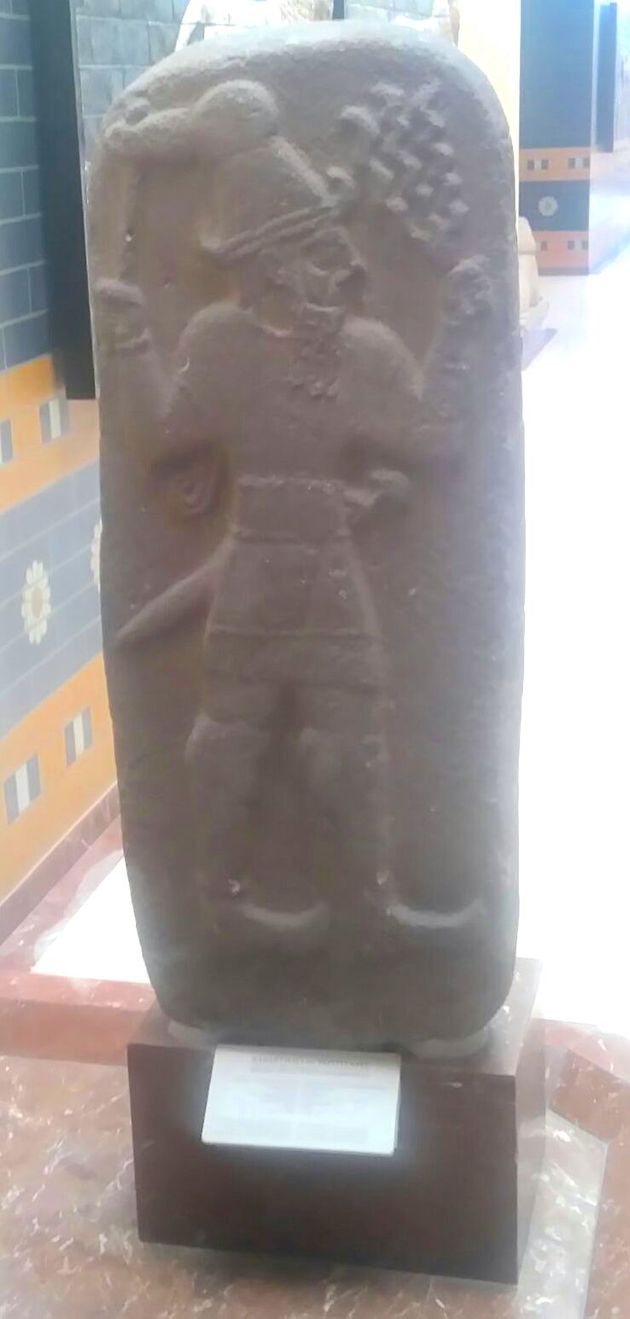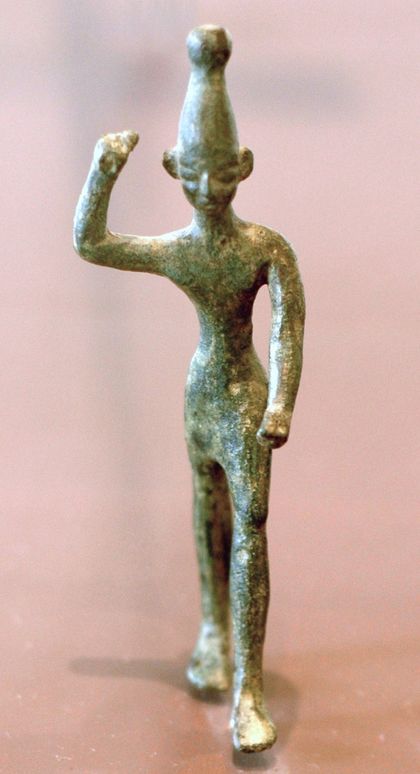Exploring the Canaanite Pantheon: Baal
Who were these Canaanites whom God ordered to be annihilated? What did they believe, what did they practice? Why was their existence such a threat to ancient Israel?
20 MARCH 2018 · 13:56 CET

This article is the first in a mini-series where we will be exploring the Canaanite pantheon.
The Canaanite religion is often overlooked by readers of the Bible and yet if any serious Biblical scholar wants to understand the text in a more profound manner, context is key.
Who were these Canaanites whom God ordered to be annihilated? What did they believe, what did they practice? Why was their existence such a threat to ancient Israel?
Our chief source of information about the Canaanite pantheon are the Ugaritic tablets discovered in 1928 in ancient Ugarit, also known as Ras Shamra in modern day Syria.
These tablets contain several myths that are shaped as dramas divided into several scenes. It is possible that as part of the Canaanite religious practices these dramas were acted out by priests and priestesses as a way of ensuring the fertility of the land.
This would perhaps explain some of the Mosaic laws regarding bestiality, incest, and some dietary laws. We will begin this mini-series by exploring the god Baal.
THE BAAL CYCLE
One of the most important myths in the fertility cults of Canaan was the Baal cycle. The Baal cycle explains the rise of Baal or Baal-Hadad as one of the chief gods of the pantheon.
Similar to how Zeus ousted Chronos as chief among the gods, the Baal cycle explains Baal’s rise to prominence and popularity among the Canaanites.
It was also a way of explaining seasonal cycles. In the myth, Baal is slain by Mot and is considered to be dead until he miraculously comes back to life through the aid of Anat.
This myth served to explain the seasons of drought and provide ritualistic practices to encourage the rebirth of Baal so that the rains would return and a fertile cycle would begin.
The first part of the cycle deals with Baal’s defeat of Yamm, the god of the seas and rivers. Baal and Yamm are in conflict as both want to lead the pantheon of the gods.
Yamm sends messengers to El and requests that Baal be surrendered to him in bondage. Baal objects and in a fit of rage wants to kill the messengers, only to be held back by Asherah and Anat.
Baal, then, makes plans to defeat Yamm. He orders two clubs to be fashioned by the god of craftsmanship called Kothar-a-Hasis. Kothar-a-Hasis gives the clubs to Baal and predicts his victory over Yamm.
Baal confronts Yamm. With the first club, Baal knocks Yamm from his throne. With the second club, Baal hits Yamm between the eyes and Yamm (the sea) falls onto the earth. Perhaps this is a mythological way of explaining the great flood, but I’m not sure.
The second part of the cycle deals with Baal’s quest to build a palace for himself. The opening scene takes part in a banquet in Mount Zephon. Baal is joined by his mother Asherah and his three daughters: Pidrai, Tallai, and Arsai.
Pidrai symbolizes light; Tallai, the dew and the rain; Arsai, the earth. Whether or not they were also Baal’s consorts and had sexual relationships with him is left ambiguous.
Perhaps this would explain the warnings in the Mosaic law against incestuous practices. The sexual life of the gods would have most likely shaped Canaanite attitudes towards sex as well.
The second scene switches the focus to Anath. Anath, the maiden warrior and hunter, is confronted by troops near her house and slays them violently. She cuts off their heads and hands, perhaps adorning herself with them. Much blood is spilled, she is knee-deep in blood.
She laughs at her victory, perhaps drinking the blood of the fallen victims. Her revelry is paused when two messengers sent by Baal arrive at her palace. She is being summoned by Baal.

Baal requests Anath’s aid so that he can have a palace of his own. Anath aims to convince El. Baal also gives gifts to Asherah to plead for his case. As Anath approaches El an earthquake ensues. El is terrified and he is cowed into granting Baal’s request. It also helps that Asherah is present to reason through this request with El.
Once the permission is granted Baal summons Kathar-a-Hasis. He builds a palace for him, but they have a debate on whether or not the palace should have a window. The reason being that Baal is scared that Yamm or other threats may take advantage of it in order to attack him.
Eventually, the palace is built and a grand opening takes place with a feast. All of the gods are invited.
The third part of the cycle begins with Mot, the god of death. He is offended at Baal’s invitation. Sensing that the new king of the pantheon is a power threat, he threatens to kill him. The stage is set for a confrontation between Mot and Baal.
Before the confrontation, Baal copulates with a heifer 88 times. This Heifer, as suggested by another myth tablet might be none other than Anat herself. Out of this union, a bull is born, a sort of clone of Baal.
Incidentally, the bull is also a symbol for El. Perhaps this serves as a foreshadowing that Baal will overtake El as the chief of the gods. In the next scene, we see Baal dead. It’s difficult to deduce whether Baal himself is dead or if his bull clone was sent as a sort of decoy to be killed in his stead. Nevertheless, everyone believes Baal is dead.
El and Asherah mourn his death by lacerating themselves. Anath is moved by feelings of vengeance. She confronts Mot and defeats him. Baal appears again! He is resurrected, or perhaps he has come out of hiding.
Everyone rejoices. Mot is terrified, and so concedes to Baal’s kingship among the gods for a 7-year cycle. Once this cycle is over Mot challenges Baal again, and the conflict between the god of the storm and the god of death is renewed again. A win by Mot means a season of drought for the land, a victory by Baal secures another cycle of fertility and abundance.
This myth is perhaps the reason for the laceration of the prophets of Baal upon their confrontation with Elijah in Mount Carmel (see 1.Kings 18:28). The lacerations may have been a way of acting out the myth in order to encourage Baal to come out of hiding.
Given Baal’s sexual relationships with Anath, I wouldn’t be too surprised that some of the cultic activities may have also included bestiality, perhaps relations with heifers, as a way of acting out the mythological drama.
THE WORSHIP OF BAAL IN ISRAEL
The name of Baal appears approximately 90 times in the Scriptures. However given that the name Baal also came to be used as a generic title meaning “Lord,” not all references are specific to the storm god “Baal-Hadad.”
Some references are to regional deities that made use of the word for “Lord,” for example Baal-Berith (Judges 8:3).
One of the reasons why Baal worship was prominent in Israel is because the Hebrews where by and large an agrarian society. Most of the Hebrews worked in the fields. So when rain didn’t come, just in case their allegiance to Yahweh were not to work, the temptation was to turn to Baal.
In its core, this is what idolatry is. A failure to trust Yahweh and turn to or trust other “redeemers” for our deliverance.
Most likely the worship of Baal started soon after the Hebrews settled in Canaan. And for the common people, it seems like worship of Baal existed alongside the worship of Yahweh from the time of the Judges onwards.
It’s not until the time of the kings that we begin to see the rise of polemical literature as the worship of Yahweh began to gain ground again.
Some scholars believe that Psalm 29 and Psalm 82 are both to be read as polemical poetry. Both psalms stress Yahweh’s superiority among the gods. Psalm 29 specifically seems to be using imagery that would be traditionally associated with Baal:
“Ascribe to the Lord the glory due his name; worship the Lord in the splendor of holiness.
The voice of the Lord is over the waters; the God of glory thunders, the Lord, over many waters.
The voice of the Lord is powerful; the voice of the Lord is full of majesty.
The voice of the Lord breaks the cedars; the Lord breaks the cedars of Lebanon.” (Psalm 29:2-5, ESV)
The waining down of Baal worship during the earlier period of the kings, however, was not going to last. Under King Ahab of Israel and his Phoenician queen Jezebel, Baal worship became widespread once again.
It is during this period that the most famous confrontation between Yahweh and Baal worship takes place in Mount Carmel. This is the challenge between Elijah and the prophets of Baal.
This confrontation can be read in 1.Kings 18. I will not be going into its details, suffice to say that this confrontation causes many in Israel to understand that Yahweh is the true God who controls the rains.
2.Kings 10:28 tells us that king “Jehu destroyed Baal from Israel.” Jehu systematically persecuted and killed worshippers and prophets of Baal. He also mounted a campaign to eradicate Baal imagery from Israel. However, despite all these efforts, by the time we reach Jeremiah, we see that Baal worship had slowly crawled its way back into Jewish society (see, Jeremiah 32:29-35).
Baal worship seemed to be a chronic disease among the people of God. It would require much more than outward acts or efforts to eradicate Baal from the heart of the Jewish populace.
What was needed was a new and transformed heart, an act of the grace and spirit of God that would transform the hearts and desires of the people.
This is what Jeremiah hinted at when saying: “And they shall be my people, and I will be their God. I will give them one heart and one way, that they may fear me forever, for their own good and the good of their children after them. I will make with them an everlasting covenant, that I will not turn away from doing good to them. And I will put the fear of me in their hearts, that they may not turn from me.” (Jeremiah 32:38-40, ESV)
Marc Madrigal is a Board member in the Istanbul Protestant Church Foundation in Turkey.
BIBLIOGRAPHY
- Herrmann, Wolfgang (1999a), "Baal", in Toorn, Karel van der; Becking, Bob; Horst, Pieter Willem van der, Dictionary of Deities and Demons in the Bible, 2nd ed., Grand Rapids: Wm. B. Eerdmans Publishing, pp. 132–139.
- Marvin H. Pope. Baal Worship. Encyclopaedia Judaica. http://www.
- Mythologies of the Ancient World. SAMUEL NOAH KRAMER (ed.). Chicago: Quadrangle Books, Inc. 1961. https://archive.org/
- Salim George Khalaf. Phoenician Canaanite Encyclopedia. https://phoenicia.org/
Published in: Evangelical Focus - Archaeological Perspectives - Exploring the Canaanite Pantheon: Baal
